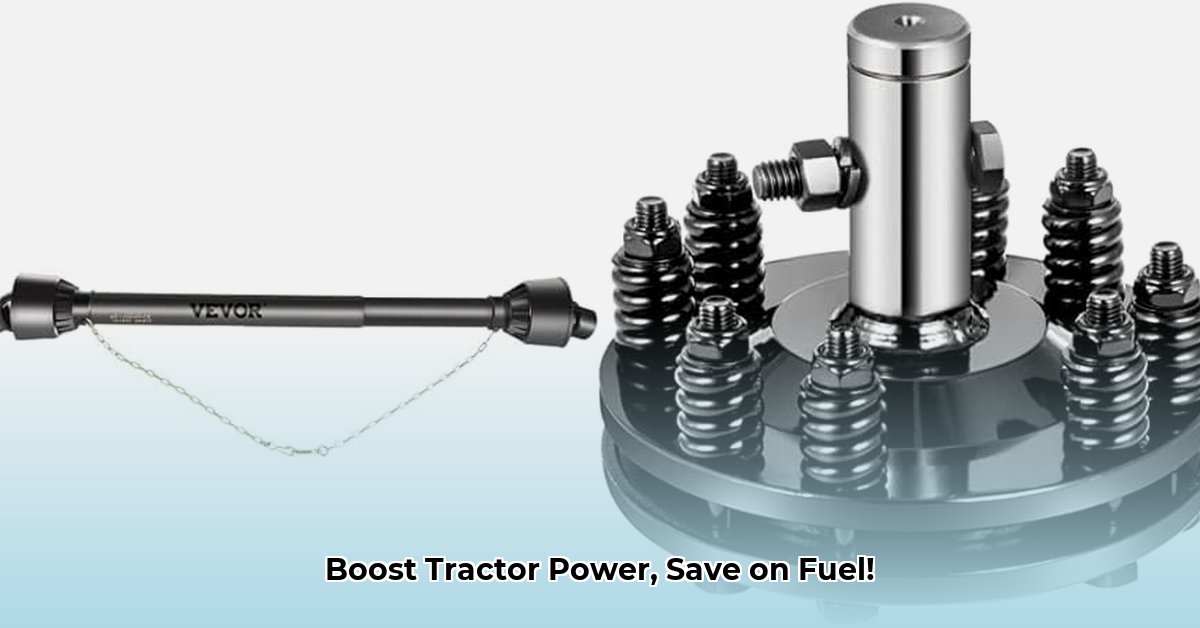
Tractor Drive Shaft: The Unsung Hero of Sustainable Farming
The tractor power take-off (PTO) shaft, often overlooked, is vital for efficient and sustainable farming. It's the crucial link transferring power from your tractor's engine to implements like tillers and balers. Optimizing its performance is key to boosting farm productivity and minimizing environmental impact. Isn't maximizing efficiency the cornerstone of profitable and responsible farming? For more on tractor mechanics, see this helpful resource.
Understanding the Power Take-Off (PTO) Shaft
The PTO shaft is the conduit of power, transferring energy from the tractor's engine to the machinery working the land. Its reliable function is essential for effective and timely field operations. Proper PTO shaft maintenance is crucial for smooth and uninterrupted operation. Consider it the backbone of your farm's mechanical processes.
Boosting Efficiency: Saving Fuel and Time
A well-maintained PTO shaft directly translates to significant savings. Reduced friction means less fuel consumption—a direct financial benefit. But the advantages extend beyond fuel economy. A smoothly running PTO shaft minimizes downtime, resulting in increased work completion, ultimately improving farm productivity. How many hours of operation could you gain annually with a properly functioning PTO system?
Sustainability: It's More Than Just Fuel
Sustainable farming goes beyond fuel efficiency—it's about resource conservation. Efficient PTO systems, powering modern implements, reduce soil compaction. Less compacted soil means healthier soil structure, improved water absorption and, subsequently, better crop yields and a more resilient ecosystem. This contributes to a more sustainable and environmentally responsible approach to farming.
Keeping Your PTO Shaft in Top Shape: Practical Maintenance Tips
Regular maintenance is paramount for optimal PTO shaft performance. Follow these steps:
Regular Lubrication: Use the manufacturer's recommended lubricant to ensure smooth operation and extended shaft lifespan. This simple step significantly impacts performance and longevity.
Visual Inspections: Regularly inspect the shaft for wear, such as bending, cracks, or worn U-joints (universal joints—the flexible joints connecting sections of the shaft). Early detection can prevent costly repairs. A visual inspection is the first line of defense against major issues.
Professional Check-ups: Schedule regular professional inspections to identify and address potential problems proactively. Preventative maintenance is far more cost-effective than emergency repairs.
Replace Worn Parts Promptly: Don't delay replacing worn components. Timely repairs prevent larger, more costly issues down the line. Addressing issues promptly safeguards your equipment and prevents prolonged downtime.
Comparing PTO Shaft Technologies: A Look Ahead
The following hypothetical comparison illustrates potential differences in PTO shaft technologies. Actual performance can vary based on several factors. Further research is needed to fully understand long-term implications.
| Technology | Initial Cost | Fuel Efficiency | Maintenance | Environmental Impact |
|---|---|---|---|---|
| Traditional PTO Shaft | Relatively Low | Moderate | Moderate | Moderate |
| Advanced PTO Shaft (Lightweight Materials) | Relatively High | High | Low | Low |
| Electric PTO Shaft (Battery-Powered) | Relatively Very High | High | Low | Very Low |
How to Integrate Renewable Energy with PTO Systems in Sustainable Farming
Key Takeaways:
- Renewable energy integration significantly reduces costs and improves environmental impact.
- PTO systems can be adapted to utilize renewable energy efficiently.
- Careful planning and consideration are vital for successful integration.
- Government support and technology advancements are increasing adoption rates.
- High initial costs, storage limitations, and regulations are key challenges.
Integrating renewable energy with your farm's PTO systems offers substantial benefits. Harnessing renewable energy for PTO-driven equipment is a growing trend in sustainable agriculture. This approach leads to a more environmentally responsible and economically viable farming model.
Integrating Renewable Energy: A Practical Approach
Energy Assessment: Determine your farm’s energy needs before implementing renewable energy. This informs the selection of the appropriate renewable energy system and capacity.
Renewable Energy Source Selection: Choose a source considering your location, available space, and budget. Options include solar, wind, and biogas.
PTO Integration Strategies: Consider direct drive, electric PTO, or hybrid systems based on your needs and resources. Direct drive directly connects renewable energy to the PTO, while electric PTO utilizes an electric motor. Hybrid systems combine multiple sources for a reliable power supply.
Energy Storage: Implement energy storage solutions (batteries or pumped hydro systems) to address the intermittent nature of renewable energy. This maintains consistent power for PTO equipment.
System Installation & Maintenance: Professional installation ensures safety and optimal performance. Regular maintenance is crucial for extending the lifespan and efficiency of your entire system.
Benefits of Integrating Renewable Energy into PTO Systems
Reduced Energy Costs: Reduces reliance on fossil fuels, leading to long-term cost savings.
Environmental Sustainability: Minimizes your farm's carbon footprint.
Energy Independence: Lessens dependence on fluctuating energy prices and potential power outages.
Challenges & Considerations
High Initial Investment Costs: While significant upfront costs exist, government incentives and financing options can assist.
Technological Complexity: Requires expertise in both renewable energy and PTO system mechanics.
Intermittency of Renewable Sources: Energy storage mitigates the intermittent nature of renewable sources.
| Renewable Energy Source | Pros | Cons |
|---|---|---|
| Solar | Abundant sunshine in many areas; low maintenance | Intermittent; land use; high upfront costs |
| Wind | High energy output in windy areas | Noise pollution; visual impact; weather-dependent |
| Biogas | Utilizes farm waste; reduces greenhouse gas emissions | Technological complexity; odor; potential safety hazards |
[This information is based on general knowledge and best practices in sustainable agriculture. Consult with relevant experts and conduct thorough research for your specific situation.]